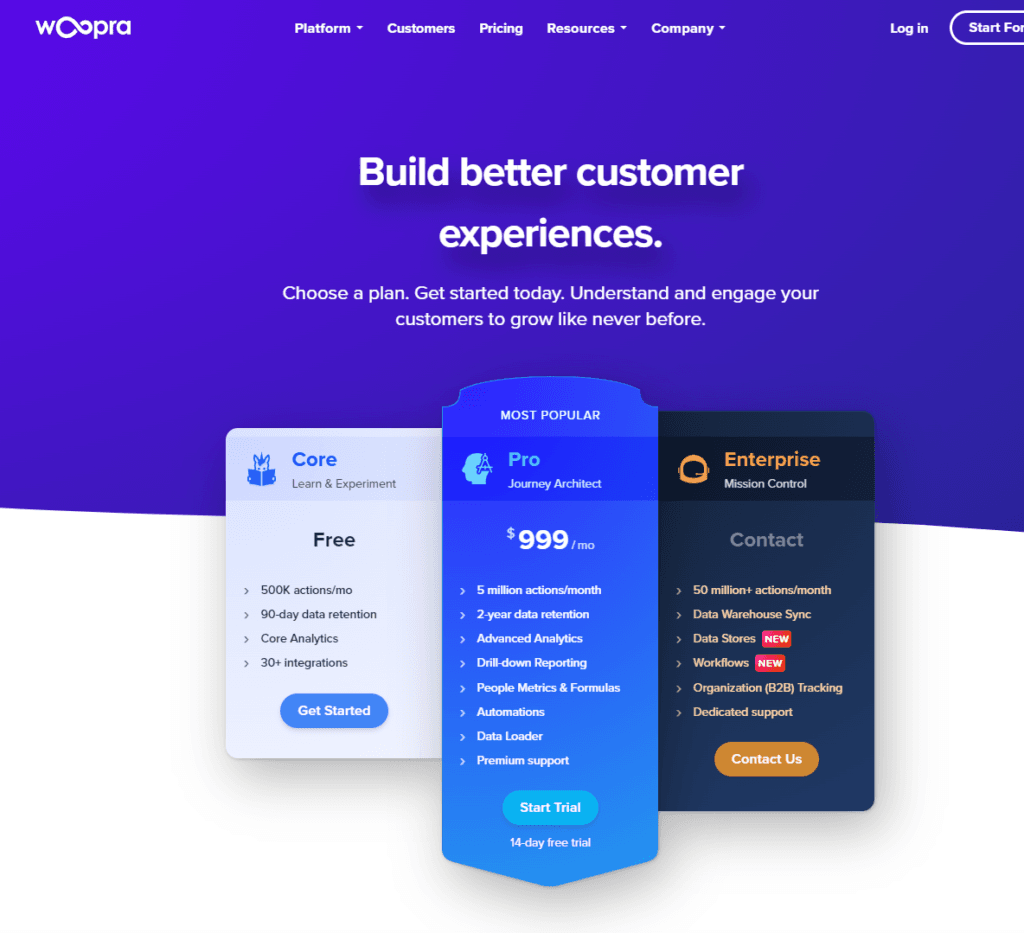In the ever-evolving landscape of digital analytics, choosing the right tool can feel like navigating a labyrinth. With countless options at your fingertips, each promising to be the key to unlocking your data’s potential, it’s easy to feel overwhelmed. Today, we’re zeroing in on two contenders: MicroStrategy and Woopra. Both have their unique strengths, but which one is the best fit for you? Let’s dive deep, compare, and decide together in a journey that’s not just about data, but about transforming that data into actionable insights.
| MicroStrategy | Woopra |
|---|---|
 |  |
| G2 Score – 4.2 out of 5 stars | G2 Score – 4.4 out of 5 stars |
| TrustRadius Score – 8.4/10 | TrustRadius Score – 5.8/10 |
Understanding the Core
Data Analytics vs Customer Journey Analytics
Before we pit MicroStrategy against Woopra, it’s crucial to understand the fundamental difference in their approaches. It’s like comparing a Swiss Army knife with a scalpel: both are tools designed for cutting, but their applications vary greatly.
MicroStrategy: The Enterprise Analytics Powerhouse
MicroStrategy stands tall as an enterprise analytics behemoth. Designed to cater to the comprehensive needs of large organizations, it’s a tool that offers depth and breadth in data analytics. Imagine having a helicopter view of an entire city, where you can zoom in on any district, street, or building to see the details. That’s the kind of overview and drill-down capability MicroStrategy brings to data analytics.
It excels in handling vast datasets, providing powerful BI (Business Intelligence) capabilities, including data mining, reporting, and predictive analytics. With MicroStrategy, organizations can integrate data from various sources, creating a unified data warehouse that serves as the foundation for making informed strategic decisions.
MicroStrategy’s strength lies in its ability to offer complex analyses and visualizations, making it a go-to choice for businesses that require a comprehensive, 360-degree view of their operations and market.
Woopra: Specializing in the Customer Journey
Woopra, on the other hand, takes a more specialized approach. It focuses on customer journey analytics, providing insights into how users interact with your product or website across multiple touchpoints. Picture being able to follow a customer as they move through a shopping mall, noting every store they enter, product they inspect, and purchase they make. Woopra offers this level of detail for the digital realm.
It’s designed to help businesses understand and optimize the customer experience from first contact to loyal advocacy. Woopra tracks individual user behavior in real-time, allowing for personalized customer experiences and targeted marketing strategies. Its strength is in its ability to segment users based on their actions, preferences, and feedback, enabling businesses to deliver tailored messages and offers.
User Interface and Experience
Navigating the Digital Analytics Seas
In the vast ocean of data analytics, the interface of your chosen tool is the compass by which you navigate. A well-designed, intuitive interface not only makes the journey smoother but also ensures that you can uncover the insights hidden beneath the surface of your data with greater ease.
MicroStrategy: Complex, Yet Comprehensive
MicroStrategy’s user interface is like a well-organized command center, equipped with an array of instruments designed to navigate complex data landscapes. It’s built for depth and breadth, offering a multitude of features and functionalities that cater to the nuanced needs of large organizations. With MicroStrategy, users have access to a comprehensive suite of analytics tools, from advanced data visualizations to sophisticated predictive analytics models.
However, this complexity comes with a steep learning curve. New users may find themselves overwhelmed by the sheer number of options and the technical knowledge required to fully leverage the platform. MicroStrategy’s interface is highly customizable, which is a double-edged sword: while it allows businesses to tailor the platform to their specific needs, achieving this level of customization can require significant time and expertise.
For organizations with dedicated data analytics teams and a need for deep, multifaceted insights, the investment in mastering MicroStrategy’s interface can pay off handsomely. But for smaller teams or businesses with more straightforward analytics needs, the complexity might be more of a hindrance than a help.
Woopra: Intuitive and Engaging
Woopra, with its focus on customer journey analytics, offers an interface that’s designed to be engaging and intuitive. It emphasizes clarity and ease of use, allowing users to quickly navigate through the platform and access the insights they need without getting bogged down in technical complexities. The dashboard is clean and user-friendly, presenting data in a way that’s easy to understand at a glance.
One of Woopra’s standout features is its real-time analytics capability, which is seamlessly integrated into the user experience. Watching live data flow in about how users interact with your website or product can be incredibly insightful and is presented in a way that’s straightforward and actionable.
Woopra’s interface makes it simple to track and analyze customer behavior across various touchpoints, making it an excellent tool for marketing teams, customer success managers, and anyone directly involved in optimizing the customer experience. Its simplicity does not sacrifice power; Woopra provides deep insights into customer behavior and preferences, all through a lens that’s focused and easy to navigate.

Related: Check out our free SEO suite

Integration Capabilities
The Art of Connection
In the sprawling ecosystem of business technology, analytics tools are just one node in a complex network. Their ability to connect with and pull data from various sources—be it CRM systems, databases, or marketing platforms—can significantly amplify their value, providing a more holistic view of business operations and customer interactions.
MicroStrategy: The Enterprise Networker
MicroStrategy is designed with the enterprise in mind, and its integration capabilities reflect this. The platform boasts robust support for connecting with a wide array of data sources, including traditional databases, big data platforms, cloud services, and various business applications. This extensive connectivity ensures that organizations can leverage MicroStrategy as a central hub for their analytics efforts, drawing on data from across the enterprise to inform decision-making.
Beyond data sources, MicroStrategy also offers APIs that enable integration with other software and systems. This allows for the embedding of analytics and interactive dashboards within business applications, portals, and even custom mobile apps. Such integrations can significantly enhance the accessibility and utility of data analytics, embedding insights directly into the workflows where they’re most needed.
However, the complexity and technical requirements of setting up and maintaining these integrations can be considerable. Enterprises looking to fully exploit MicroStrategy’s integration capabilities may need to invest in IT resources and expertise, making it more suited to larger organizations with the necessary infrastructure.
Woopra: Streamlined and Focused Integration
Woopra’s approach to integration is somewhat different, focusing on simplicity and direct applicability to customer journey analytics. It offers seamless integration with a curated list of tools and platforms commonly used in marketing, sales, and customer service. This includes CRM systems, email marketing platforms, support ticketing systems, and more. The aim is to provide a unified view of the customer journey by consolidating data from these touchpoints into a cohesive narrative.
Woopra’s integrations are generally straightforward to set up, requiring minimal technical expertise. This ease of integration makes Woopra an attractive option for small to medium-sized businesses or teams within larger organizations that are specifically focused on optimizing customer experiences.
While the range of integrations might not be as extensive as MicroStrategy’s, the ones Woopra supports are deeply integrated into its functionality, enabling advanced segmentation, real-time analytics, and personalized automation based on comprehensive customer data.
Scalability and Future-proofing
Growing with Your Data
The digital era is marked by rapid change, not just in terms of technology advancements but also in the evolving nature of business challenges and opportunities. An analytics tool that can scale and adapt over time is not just an asset but a necessity for future-proofing your business intelligence strategy.
MicroStrategy: Built for Enterprise Growth
MicroStrategy’s architecture is inherently designed for scalability, catering to the expansive needs of large enterprises. It provides a robust foundation that can handle increasing volumes of data, more complex analytics requirements, and a growing user base without sacrificing performance or security. This is achieved through a combination of on-premise and cloud-based solutions, offering flexibility in deployment and scalability.
Furthermore, MicroStrategy invests heavily in research and development, ensuring that its platform evolves in line with technological advancements and market trends. This commitment to innovation means that MicroStrategy is continually enhancing its features, integrating new data sources, and improving its analytics capabilities to meet the future needs of its users. For organizations looking for an analytics solution that can grow and adapt with them over the long term, MicroStrategy presents a compelling option.
Woopra: Agile and Adaptable for the Dynamic Business
Woopra’s approach to scalability is somewhat different, focusing on agility and flexibility. Designed to serve businesses of varying sizes, from startups to mid-sized companies, Woopra allows for easy adjustment of features and services based on changing needs. This adaptability is crucial for businesses in fast-moving sectors or those experiencing rapid growth, where the ability to quickly pivot and respond to new challenges is vital.
In terms of future-proofing, Woopra is dedicated to staying at the forefront of customer journey analytics, continuously updating its platform to incorporate the latest trends in consumer behavior and digital marketing. Its cloud-native architecture means that updates and new features can be rolled out quickly and seamlessly, ensuring that businesses always have access to cutting-edge tools for understanding and engaging their customers.
Cost and Return on Investment
Balancing the Scales
In the world of business, every tool, every resource, and every strategy must justify its place not just through its capabilities, but through its contribution to the organization’s bottom line. This is especially true for analytics platforms, which are tasked with turning raw data into actionable insights that can drive growth, efficiency, and innovation.
MicroStrategy: The Enterprise Investment

MicroStrategy’s pricing model is tailored to large enterprises and reflects the platform’s comprehensive capabilities and the depth of insights it provides. It typically involves a significant upfront investment, with costs associated with licenses, server space, and potentially additional fees for premium features and integrations. The platform is designed to be scalable, with pricing that can adjust based on the size of the deployment, the number of users, and the specific needs of the organization.
The ROI of MicroStrategy is often realized through its ability to inform strategic decisions across the enterprise, optimize operations, and identify opportunities for cost savings and revenue generation. Its powerful analytics can uncover inefficiencies, predict market trends, and provide a data-driven foundation for decision-making that can significantly impact an organization’s profitability and growth. However, achieving this level of ROI requires a commitment to mastering the platform and integrating it deeply into the organization’s decision-making processes.
Woopra: Focused Investment for Customer-Centric ROI

Woopra offers a pricing model that’s more accessible to a broader range of businesses, from startups to mid-sized organizations, making it an attractive option for those focused specifically on optimizing the customer journey. The platform typically uses a subscription-based model, with costs varying depending on the number of events tracked, features used, and level of support required. This allows businesses to scale their use of the platform as they grow, adjusting their investment according to their changing needs.
The ROI from Woopra comes from its ability to enhance customer experiences, improve conversion rates, and increase customer loyalty and lifetime value. By providing deep insights into the customer journey, Woopra enables businesses to tailor their marketing, sales, and support efforts to the needs and preferences of their audience, driving higher engagement and revenue. For organizations with a strong focus on customer-centric growth strategies, Woopra’s targeted insights can offer a clear path to a strong return on investment.
Conclusion
MicroStrategy shines as a robust, enterprise-level analytics powerhouse, designed to serve the complex needs of large organizations. It stands out for its comprehensive data analytics capabilities, scalability, and the ability to integrate with a multitude of data sources and systems. MicroStrategy is built for the long haul, offering a stable foundation that can support an organization’s growth and evolving data analytics requirements over time. Its investment in innovation ensures that it remains at the cutting edge of business intelligence, making it a suitable choice for enterprises seeking a deep, strategic understanding of their data.
Woopra, on the other hand, specializes in customer journey analytics, providing a more focused and user-friendly platform. It excels in offering real-time insights into customer behavior, making it an invaluable tool for businesses looking to enhance customer experiences, increase engagement, and drive growth through targeted, data-driven strategies. Woopra’s flexibility, ease of integration with marketing and sales tools, and its agile, adaptable nature make it particularly appealing to small and medium-sized businesses, as well as specific teams within larger organizations focused on customer-centric objectives.
Read Next:
- The Future of Email Marketing: Predictions and Trends to Watch
- Segmentation in Email Marketing: Targeting the Right Audience with the Right Message
- The Power of A/B Testing in Email Marketing: Making Data-Driven Decisions
- How I Achieved a 400% ROI with My Latest Email Marketing Campaign
- 31+ Top Social Media Management tools Compared! (2023)




















